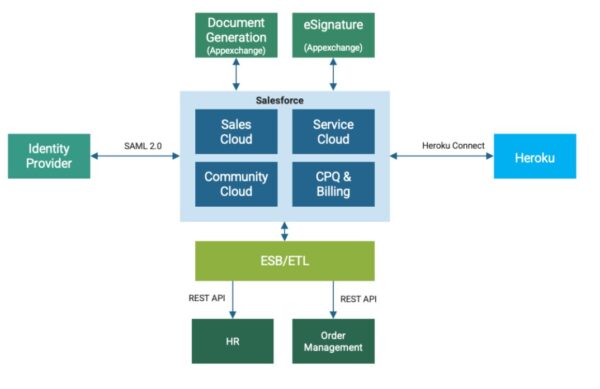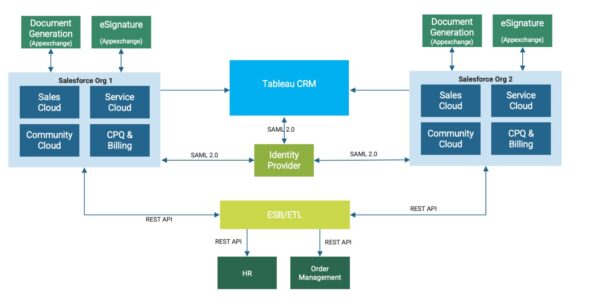How to Develop a Foolproof Salesforce Org Strategy
Are you considering deploying Salesforce in your organization? What type of Salesforce org strategy you choose affects how your business uses Salesforce and how it affects your operations and management. Should you choose a single org strategy or a multi-org strategy? It all depends on your firm’s unique nature and needs.
Why Your Salesforce Org Strategy is Important
When you implement Salesforce in your company, you can choose a strategy that creates a single org or multiple orgs. The Salesforce org strategy you choose needs to align with how you employ Salesforce in your company. It determines the basis for your Salesforce implementation and impacts all your resulting designs and initiatives. It even impacts your operation’s staffing, budget, and overall functionality.
In short, selecting a Salesforce org strategy is one of the most important decisions you have to make when implementing Salesforce. Everything you subsequently do tracks off the org strategy you choose.
Single Org vs. Multi-Org Strategy
You can employ one of two basic Salesforce org strategies—single org or multi-org. There are benefits to both.
Benefits of a Single Org Strategy
A single-org architecture organizes all data and business processes in a single Salesforce instance. A single-org strategy is best suited for organizations that employ a single business process with a relatively simple architecture.

The primary benefits of a single-org strategy include:
- Enhanced visibility of the entire business process
- Standardized processes
- Improved collaboration
- Less duplicative effort
- Economies of scale
If your organization increases in size and complexity, these changes can negate these benefits.
Benefits of a Multi-Org Strategy
A multi-org architecture is built on multiple instances of Salesforce. There are several different variations of the multi-org structure, including:
- Hub-and-spoke, with one central hub org for data access
- Point-to-point, where each org is connected to the others when needed
- Autonomous orgs, where each org is independent of the others
A multi-org structure is best for organizations utilizing multiple processes or having separate processes for different business units. It’s also recommended for organizations with business units in different regions with different legal or privacy regulations.

The primary benefits of a multi-org strategy include:
- Greater autonomy for each business unit
- Reduces the risk of exceeding org limits
- Greater flexibility
- Improved time to market
- Reduced complexity within each org
The downsides of the multi-org approach include the necessity for increased administrative resources and increased costs.
Four Key Factors for Choosing a Salesforce Org Strategy
You need to consider several factors when deciding on which type of org strategy to employ in your organization. The four primary factors include your firm’s:
- Business
- Technology
- Governance and culture
- Operations
We’ll look at each factor in more detail.
Business
The first factor to consider is the business you’re in and how it works. You need to consider your different business units, how they’re structured and operate, and how they engage with their individual customer bases.
In particular, think about the following questions:
- What does your company prioritize—speed to market and innovation or consolidating business processes in a common organization? A multi-org strategy is best for innovation, while a single strategy helps to standardize processes across the entire organization.
- How many business units and locations does your firm have or is likely to expand to in the coming years? A single org strategy is fine if you have only a few business units or locations and if they’re relatively similar. A multi-org strategy may be necessary if you have many disparate business units or locations.
- How important is it to share common data and maintain standard business practices across the organization? A single org structure is best if standardized operations are important to you. If your operations are decentralized, consider a multi-org approach.
Technology
Your organization’s data and technology strategies can impact the Salesforce org structure you choose. Consider the following:
- Application architecture
- Functionality
- Data strategies
- Data volume
With all these factors, the greater the complexity across business units or locations, the more beneficial a multi-org structure becomes. The more centralized and standardized your technology strategy, the easier it is to accomplish with a single org Salesforce approach.
Governance and Culture
It’s important to consider how your organization’s governance and culture—both company-wide and within individual business units—will be impacted by the type of Salesforce org structure you choose. You need to evaluate:
- Sponsorship and ownership of the Salesforce implantation
- Budgets and labor resources
- IT and business unit-level governance
You also need to consider how ready your organization is for this change, both at the top and across all locations and business units. If you currently operate in a decentralized fashion, moving to a single org structure could be jarring. Similarly, if your firm is used to strong centralized management, going with a multi-org structure would be a major change for all concerned.
Operations
Finally, consider your firm’s current operations and how well suited they might be for each type of org strategy. Evaluate these factors:
- Fast deployment (single org) vs. shared functionality (multi-org)
- Multilevel centralized support (single org) vs. individual support teams (multi-org)
- Centralized DevOps (single org) vs. decentralized release management (multi-org)
Which Salesforce Org Strategy Is Best for Your Organization?
No given Salesforce org strategy is best for all organizations. It’s not a one-size-fits-all scenario. Since every organization is unique in both structure and operation, the choice of Salesforce org structure has to be an individual one.
It may very well be the case that, after analyzing your individual situation, you may determine that both single org and multi-org strategies present strengths and weaknesses for your firm. When this is the case, choosing the best org strategy involves hard decisions and compromise, which employing an experienced Salesforce consultant can ease.
Let Rainmaker Help You Develop a Foolproof Salesforce Org Strategy
When you’re evaluating or planning to implement Salesforce in your organization, turn to the Salesforce experts at Rainmaker. We can help you develop and execute a successful Salesforce implementation, including the best org strategy for your situation. We’ve been helping businesses implement and get more out of the Salesforce platform for over two decades. Talk to us to learn more about our Salesforce managed services designed to meet all your Salesforce-related needs.
Contact Rainmaker today to learn more about developing the best Salesforce org strategy for your organization!






